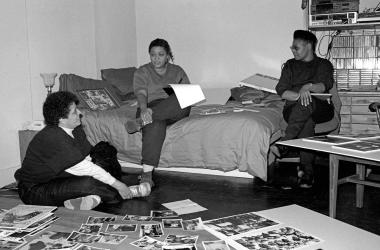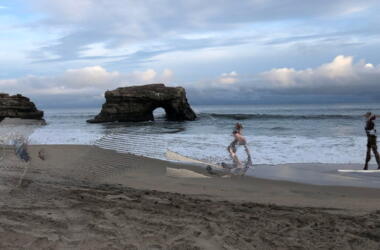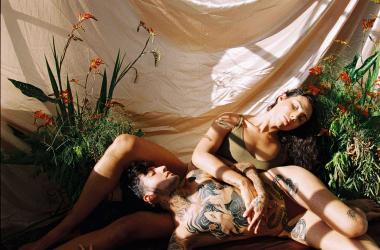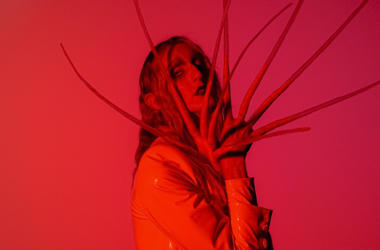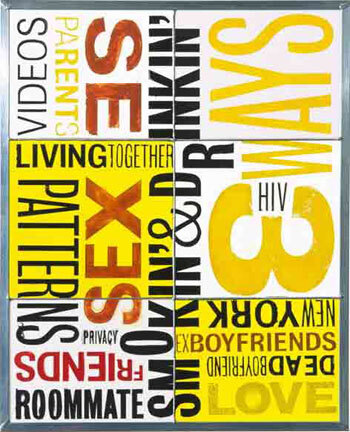
Image
JOSEPH CAVALIERI Smoking and Drinking, 2005 Stained glass 22 x 18" Private Collection NYC
PAST
JOSEPH CAVALLERI: Stained / Painted Glass
Jan 10, 2006 - Feb 25, 2006
Stained Glass as Fine Art
By Joseph Cavalieri
(from THE ARCHIVE: No. 19: Spring 2006)
In 2002, while I was working at People magazine, a headhunter recruited me to art direct a start-up magazine named In Touch. I quit after working two days. I sent a couple of e-mails to coworkers back at People saying the magazine was “not up to my standards.” The next day, Keith Kelly at the New York Post reported “Sources say Joe Cavalieri…left after only a week, claiming he did not think the publication would be high-quality enough for him.” The following day, the reply from the editor-in-chief at In Touch read: “…I’m sure he [Cavalieri] is painting the Sistine Chapel by now.” I have taken this as a challenge, and this showcase at Leslie/Lohman brings me one step closer to making his statement true.
What follows is my view on stained glass: its history, techniques and current state.
THE BEGINNING
The making of glass itself dates back to 2500 BC in Mesopotamia. Based on remains found at Pompeii and Herculaneum, stained glass was first used by wealthy Romans in their palaces in the first century AD. During my visit to Herculaneum in 1990, I saw the remains of a huge bathhouse with erotic frescos and mosaics, a perfect location for stained glass.
THE DETAILS OF ROUNDELS
From 1480 to 1560 in the Burgundian-Habsburg lowland of what is now the Netherlands and Germany, “roundels” were produced. Roundels are black paintings done on clear glass that measure about ten inches around. These paintings are mind-blowing and are as
intricate as engravings. The only color added was from silver stain, which was fired onto the back of the glass, producing a bright yellow-orange stain. I consider this period of time to have produced the best in detailed drawings on glass.
THE RICH COLORS OF TIFFANY
Fast forward to Tiffany—Louis, that is. I find the most unique thing about Louis Comfort Tiffany (1848–1933) and his craftsmen is not the lamps and windows they produced, but the fact that they made the glass by hand. A whole new array of brightly colored glass and patterns were produced. The color choices are vast—my favorites are the saturated orange and reds.
MAKING STAINED GLASS NEW AGAIN
The process of making a painted stained glass window hasn’t changed much since medieval times. Colored glass is created by adding metallic salts and oxides to glass when it is in a liquid state.
- Here are the steps I take when creating a panel:
- I start by sketching the design. This step can take a couple of days or a few months.
- Next, I enlarge the sketch to full size and map it out. This drawing, called a cartoon, is divided into distinct colored areas, each representing a different piece of glass.
- Next, the glass is cut to size and painted. One ingredient of the paint is very finely ground glass.
- Next, the glass is heated to over 1,250° F. in the kiln. (Unlike Shrinky Dinks, the popular shrinking plastic toy of the 1970s, the glass does not shrink when heated.) The paint permanently melts onto the surface of the glass. This is one reason why medieval stained glass windows have survived this long (even though over time, the leading deteriorates and needs to be replaced).
- Once cooled, the glass pieces are foiled and soldered together. Framing and interior lighting of the panel follows.
CURRENT STATE OF STAINED GLASS
The public is exposed to glass work at craft fairs and in church windows. Unfortunately, much of the work is repetitive or tragically bad. I hope these words and photos have brought a better understanding to this ancient art form. I will continue my quest to create a glass version of the “Sistine Chapel.” Hey, Charles and Fritz: Does the new space need a glass ceiling?
I want to thank my longtime friend and multitalented artist Theodore Titolo for introducing me to the staff at Leslie/Lohman.
Joseph Cavalieri’s very first glass chandelier will be auctioned at Urban Glass’s Annual Glassblowers Ball, at Chelsea Piers, this April. (See www.urbanglass.org.) To view the chandelier, see more work, or arrange a workshop visit log on to: CAVAglass.com. Cavalieri recently exhibited his work at LLGAF Jan. 10–Feb. 25, 2006.
Related

PAST
Chitra Ganesh: A city will share her secrets if you know how to ask
Oct 18, 2020 - Jun 01, 2022
more
PAST
DARK RIDE: A Nocturnal Journey into the World of Erotic Desire
May 08, 2007 - Jun 30, 2007
more
PAST
SELDOM SEEN: Never or rarely seen works from the permanent collection
Nov 17, 2009 - Jan 23, 2010
more
PAST
LESBIANS SEEING LESBIANS: Building Community in Early Feminist Photography
Sep 14, 2011 - Dec 22, 2011
more
PAST
QUEERS IN EXILE: the Unforgotten Legacies of LGBTQ Homeless Youth
Jul 17, 2013 - Jul 28, 2013
more
PAST
Nude In Public: Sascha Schneider: Homoeroticism and the Male Form circa 1900
Sep 20, 2013 - Dec 08, 2013
more
PAST
INTERFACE: Queer Artists Forming Communities through Social Media
May 15, 2015 - Aug 02, 2015
more
PAST
MEDIUM OF DESIRE: An International Anthology of Photography and Video
Dec 18, 2016 - Mar 27, 2016
more
PAST
RUBBISH AND DREAMS: The Genderqueer Performance Art of Stephen Varble
Sep 29, 2018 - Jan 27, 2019
more
PAST
ROBERT GIARD (1939-2002) Particular Voices: Portraits of Gay & Lesbian Writers
Apr 25, 2018 - May 20, 2020
more





